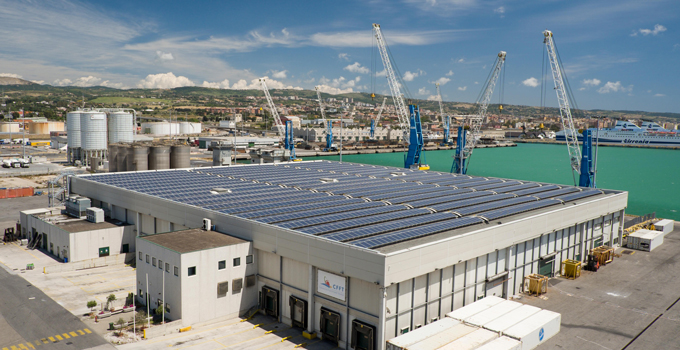THOUGHT LEADERSHIP
Protecting your embedded generator from islanding without breaking the bank
If you are planning to generate some of your own electricity, such as through a few wind turbines or a small solar farm, you’ll need to know about islanding.

Adding new embedded generation such as wind or solar into the power grid can produce some challenges, but these challenges can be overcome. One such concern is the potential for network faults to cause islanding – in other words, when an embedded generator keeps supplying power to a grid when the grid power falls or fails, forming an island.
Understanding the cost implications of anti-islanding protection will help you negotiate with your network service provider, and may help you save money on a fit-for-purpose solution.
Network service providers (NSPs) are particularly sensitive to the risk of islanding. Although the probability of an island developing is low, the potential for islanding causes NSPs concerns about safety, about delivery of poor-quality electricity, and about the chance of damage to their equipment.
However, the high costs of some anti-islanding measures could cripple your embedded generation project, so you need to be aware of your options.
How can islanding be detected?
To protect against islanding, many NSPs will install high-speed communications circuits between your new plant and their substation or control centre. This works well: the NSP determines that an island may be forming and sends a trip signal to your generator. However, the communications circuit is expensive and, typically, the cost will come out of your pocket. The extra expense might spell the end for your power project, regardless of its size.
In the future, the gold standard in anti-islanding protection is likely to be based on synchrophasors, so that the phase angle of various parts of the grid can be compared and a tripping decision can be made without involving the NSP control centre. This method will still require high-speed communications circuits.
It is common for proponents to consider ‘passive’ anti-islanding protection based on measurements made at the generator. The usual measurements made to detect islanding are over/under voltage, over/under frequency, rate of change of frequency, and vector shift. The NSP is likely to ask what will happen if the island load matches the island generation. In a purely academic sense, if the load matches the generation then none of these elements will detect the island. But is this concern warranted in practice?
The bigger risk you will face, particularly in off-grid networks, is that the rate of change of frequency or the vector shift will trip your generator unnecessarily. It is very difficult to set vector shift protection sensitively enough that it will detect an island but not malfunction during a network fault.
What’s the best option?
If you are connecting an inverter-based system (e.g. a solar farm or a type 4 wind turbine) make sure that it has ‘active’ anti-islanding protection and that the inverter documentation discloses the method being used. In Australia, simply specifying compliance with the standard AS 4777 is sufficient.
Specialist advice on how the active anti-islanding protection operates will help you and your NSP determine whether you can avoid the need for high-speed communications and use a lower cost communications circuit such as 3G.
If you are connecting an induction generator, you might think that it is not possible to supply an islanded load. It is not impossible, just unlikely. Your NSP may not accept unlikely, when you could install a high-speed communication circuit and eliminate the risk at no additional expense to them.
Although an induction generator can sometimes supply an islanded load, it is almost impossible for it to do that at nominal voltage and frequency. Passive protections can be applied and are likely to work reliably. The rate of change of frequency protection is particularly useful in this case because, unlike vector shift, it is not susceptible to network faults as long as you select a relay with the right algorithm.
If you are connecting a synchronous machine, you’re providing valued inertia, but you may have the largest anti-islanding challenge. The synchronous generator can supply an island indefinitely and often without going far outside the nominal system voltage and frequency.
In this situation, there are three alternatives:
- You could attempt to convince your NSP that the power you provide to any island will be of the highest quality and that there is no need to panic if an island is created for a short time. The NSP will likely ask you to fund the installation of one or more new voltage transformers in their network.
- You could accept that high-speed communications really are required to safely incorporate your new generator into the network, and shoulder the expense.
- You could apply vector shift protection to your generator and accept that there will be occasional instances in which your machine will trip off and need to be restarted following a network fault.
Anti-islanding protection is complex, and it adds an extra hurdle in the process of embedding small generators in our networks, but this challenge can be resolved satisfactorily. By being better aware of your options, you’ll be much more likely to achieve a safe and cost-effective solution that meets your needs as well as the requirements of your NSP.
If you would like to find out more about how Entura can help you overcome islanding and other electrical challenges, please contact David Wilkey on +61 3 6828 9749 or Patrick Pease.
About the author
David Wilkey is Entura’s Principal Consultant, Secondary Electrical Engineering. He has more than 20 years of consulting experience in electrical engineering across Australia and New Zealand, focusing on the delivery of advisory on secondary systems and power systems engineering. David’s expertise spans all areas of electrical engineering with a particular focus on electrical protection, power system studies and rotating electrical machines.
MORE THOUGHT LEADERSHIP ARTICLES
May 24, 2017






